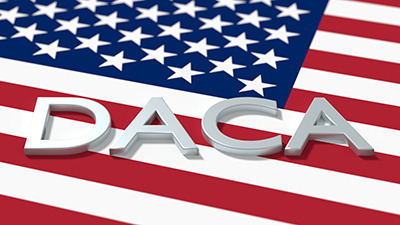It isn’t any secret that immigration issues have been a hot topic in employment for the last several years. One such issue involved the Deferred Action for Childhood Arrivals program, commonly referred to as “DACA.” A recent U.S. Supreme Court case shed some light on that program for employers—for now. Here are the details.

What Is DACA?
In 2012, President Barack Obama afforded some protections to individuals who had been brought to the United States without documentation while they were children through a program called DACA. The DACA immigration policy defers deportation for two years. DACA applicants cannot have felonies or serious misdemeanors on their records and must pass background and fingerprint checks.
Individuals who become DACA recipients are permitted to get driver’s licenses, attend school, and obtain work permits. Since DACA’s creation in 2012, more than 825,000 individuals have been approved for the program. An employee who is authorized to work through DACA is category C33 on his or her Employment Authorization Document (Form I-766)
Viability of DACA Program Has Been Touch-and-Go
In September 2017, then-Attorney General Jeff Sessions’ announced the government would be ending the DACA program in March 2018. According to the announcement, the government would stop accepting new DACA applications effective September 6, 2017, although it would continue to accept renewal requests for anyone whose then-current work permit expired before March 5, 2018.
Anyone whose DACA work permit expired after March 5, 2018, would no longer be authorized to live, study, and work in the United States and would have been subject to deportation at the time their authorization expired.
The announcement led to a number of lawsuits nationwide, and not surprisingly the courts didn’t always agree on the topic. For example, federal judges in California and New York questioned the administration’s decision to end DACA and ordered U.S. Citizenship and Immigration Services (USCIS) to accept DACA renewal applications while the cases in those jurisdictions proceeded.
On the other hand, a federal judge in Maryland held the decision to end DACA was lawful. Due to the conflict among the courts, the Supreme Court of the United States took up the issue this year.
Supreme Court Weighs In
In June 2020, the Supreme Court issued a ruling in Department of Homeland Security et al. v. Regents of the University of California, et al. agreeing with some federal courts that the reasoning given for DACA’s rescission was arbitrary and capricious under the Administrative Procedure Act (APA), which governs the process by which federal agencies develop and issue regulations.
The bottom line is that the Supreme Court allowed the DACA program to continue, not because it was illegal to end it but because the way the Trump administration attempted to end it was inconsistent with the APA.
DACA Remains in Jeopardy
So what does this mean for employers? While it’s possible the Trump administration will attempt to end the program again, for now, employees can continue to apply for the DACA program and, if approved or renewed, can continue to live and work in the United States. Employees who are authorized to work in the United States through this program can continue to do so.
Amelia J. Holstrom is a partner at the firm of Skoler, Abbott & Presser, P.C. Amelia can be reached at aholstrom@skoler-abbott.com.
